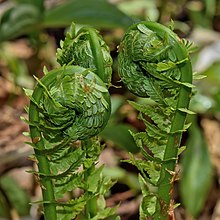
The ferns are a group of vascular plants that reproduce via spores and have neither seeds nor flowers. They differ from mosses by being vascular, i.e., having specialized tissues that conduct water and nutrients and in having life cycles in which the branched sporophyte is the dominant phase.

Fiddleheads or fiddlehead greens are the furled fronds from a fledgling fern, harvested for use as a vegetable.

Dryopteris, commonly called the wood ferns, male ferns, or buckler ferns, is a fern genus in the family Dryopteridaceae, subfamily Dryopteridoideae, according to the Pteridophyte Phylogeny Group classification of 2016 (PPG I). There are about 300-400 species in the genus. The species are distributed in Asia, the Americas, Europe, Africa, and the Pacific islands, with the highest diversity in eastern Asia. It is placed in the family Dryopteridaceae, subfamily Dryopteridoideae, according to the Pteridophyte Phylogeny Group classification of 2016 (PPG I). Many of the species have stout, slowly creeping rootstocks that form a crown, with a vase-like ring of fronds. The sori are round, with a peltate indusium. The stipes have prominent scales.

Onoclea sensibilis, the sensitive fern, also known as the bead fern, is a coarse-textured, medium to large-sized deciduous perennial fern. The name comes from its sensitivity to frost, the fronds dying quickly when first touched by it. It is sometimes treated as the only species in Onoclea, but some authors do not consider the genus monotypic.

Onoclea is a genus of plants in the family Onocleaceae, native to moist habitats in eastern Asia and eastern North America. They are deciduous ferns with sterile fronds arising from creeping rhizomes in spring, dying down at first frost. Fertile fronds appear in late summer. Depending on the authority, the genus contains one to five species.
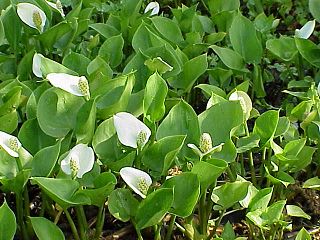
Calla is a genus of flowering plant in the family Araceae, containing the single species Calla palustris.

Polystichum is a genus of ferns in the family Dryopteridaceae, subfamily Dryopteridoideae, according to the Pteridophyte Phylogeny Group classification of 2016. The genus has about 500 species and has a cosmopolitan distribution. The highest diversity is in eastern Asia, with about 208 species in China alone; the region from Mexico to Brazil has at least 100 additional species; Africa, North America, and Europe have much lower diversity. Polystichum species are terrestrial or rock-dwelling ferns of warm-temperate and montane-tropical regions. They are often found in disturbed habitats such as road cuts, talus slopes, and stream banks.

Onocleaceae is a small family of terrestrial ferns in the order Polypodiales. It is placed in the suborder Aspleniineae in the Pteridophyte Phylogeny Group classification of 2016. Alternatively, the family, along with Blechnaceae, may be placed in a very broadly defined family Aspleniaceae as the subfamily Blechnoideae. The family may contain from one to four genera, consisting of five species largely in north temperate climes. The four genera, Matteuccia, Onoclea, Onocleopsis and Pentarhizidium, may be included under the single genus Onoclea.
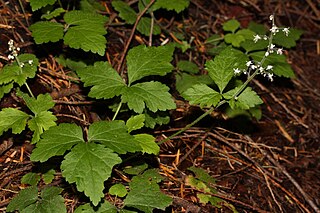
Tiarella trifoliata, the three-leaf foamflower, is a species of flowering plant in the family Saxifragaceae. The specific name trifoliata means "having three leaflets", a characteristic of two of the three recognized varieties. Also known as the laceflower or sugar-scoop, the species is found in shaded, moist woods in western North America.

Pteris vittata, the Chinese brake, Chinese ladder brake, or simply ladder brake, is a fern species in the Pteridoideae subfamily of the Pteridaceae. It is indigenous to Asia, southern Europe, tropical Africa, and Australia. The type specimen was collected in China by Pehr Osbeck.

Amauropelta noveboracensis, the New York fern, is a perennial species of fern found throughout the eastern United States and Canada, from Louisiana to Newfoundland, but most concentrated within Appalachia and the Atlantic Northeast. New York ferns often forms spreading colonies within the forests they inhabit.
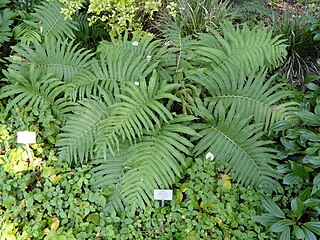
Pentarhizidium is a genus of two Asian fern species. These species have formerly been included in Matteuccia or Onoclea. Recent genetic analysis has determined that these two species form a discrete clade that is basal to the rest of this fern group, and so have been located in their own genus. P. orientale is sometimes grown as a garden plant.

Angiopteris evecta, commonly known as the king fern, giant fern, elephant fern, oriental vessel fern, Madagascar tree fern, or mule's Foot fern, is a very large rainforest fern in the family Marattiaceae native to most parts of Southeast Asia and Oceania. It has a history dating back about 300 million years, and is believed to have the longest fronds of any fern in the world.
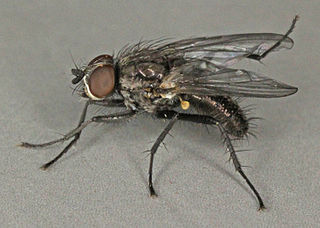
Chirosia betuleti is a species of fly, which causes knotting gall in ferns. The gall develops in the terminal shoots of ferns, such as broad buckler fern, male fern, lady fern, and ostrich fern.

Chenopodiastrum is a genus of herbaceous flowering plants in the family Amaranthaceae. The genus was formally described in 2012. The 5 species occur in Eurasia, North Africa, and North America.
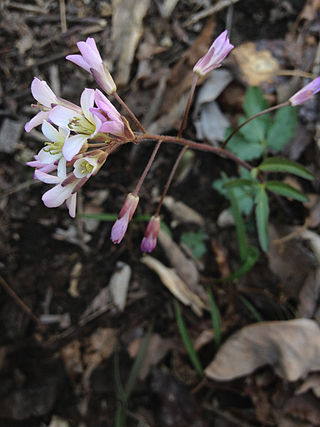
Cardamine angustata is a perennial forb native to the eastern United States, that produces white to pink or purple flowers in early spring.

Symphyotrichum oolentangiense, commonly known as skyblue aster and azure aster, is a species of flowering plant in the family Asteraceae native to eastern North America.

Polystichum polyblepharum, the Japanese lace fern or tassel fern, is a species of plant in the wood fern family Dryopteridaceae, native to Japan and South Korea. Growing to 1 m (3.3 ft) tall and broad, it forms clumps ("shuttlecocks") of evergreen fronds.

Pyrularia is a small genus of shrubs or small trees in the sandalwood family (Santalaceae) which contains two species, Pyrularia pubera and Pyrularia edulis. P. pubera grows in the eastern United States and P. edulis grows in Bhutan, China, India, Myanmar, and Nepal. Both species are parasitic plants, specifically hemiparasites, which while still photosynthetic, will also parasitize the roots of other plants around them.
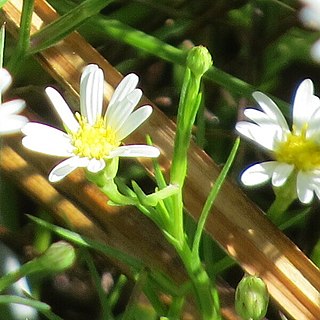
Symphyotrichum potosinum is a species of flowering plant in the family Asteraceae native to Mexico and the U.S. state of Arizona. Commonly known as Santa Rita Mountain aster, it is a perennial, herbaceous plant that may reach heights of 15 to 45 centimeters.
